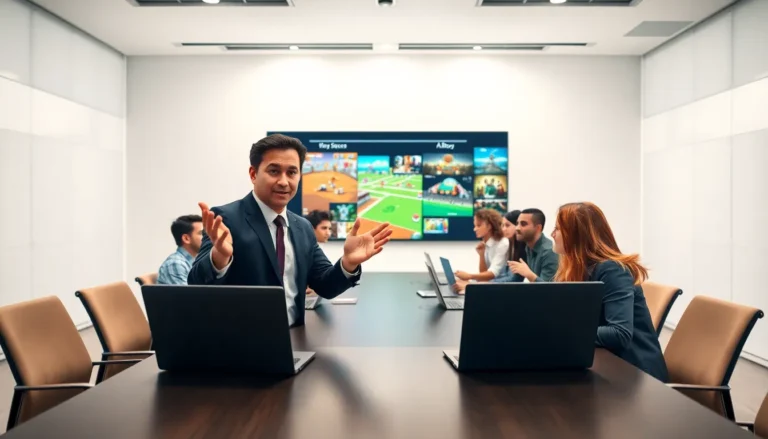In today’s fast-paced world, home technology solutions have become essential for creating comfortable and efficient living spaces. From smart thermostats that learn preferences to security systems that offer peace of mind, these innovations transform how people interact with their homes. Embracing technology not only enhances convenience but also promotes energy efficiency and safety.
As homeowners seek to simplify their lives, the demand for integrated tech solutions continues to rise. Whether it’s automating lighting or monitoring home security remotely, these advancements cater to diverse needs and lifestyles. Exploring the latest home tech solutions reveals a world of possibilities that can elevate everyday living to new heights.
Table of Contents
ToggleOverview of Home Tech Solutions
Home tech solutions encompass a range of technologies designed to enhance comfort, convenience, and security within residential spaces. These innovations streamline daily tasks and improve the overall quality of life for homeowners.
Definition of Home Tech Solutions
Home tech solutions refer to integrated systems and devices that automate tasks and enhance living environments. Examples include smart thermostats, automated lighting, and security systems. These technologies connect to a central network, enabling users to control and monitor various aspects of their home through mobile apps or voice commands.
Importance in Modern Living
Home tech solutions play a vital role in modern living by promoting convenience, energy efficiency, and safety. They allow homeowners to manage energy consumption effectively, with smart thermostats adjusting temperatures based on occupancy. Security technologies provide peace of mind through remote monitoring and alerts, fostering a sense of safety. The rise in demand for these solutions reflects a shift towards more efficient and interconnected home environments, fulfilling the needs of a tech-savvy population.
Popular Home Tech Solutions

Home tech solutions encompass a variety of devices and systems that streamline everyday tasks and enhance living environments. This section explores some of the most popular options available today.
Smart Home Devices
Smart home devices include gadgets like smart speakers, smart bulbs, and smart plugs. These devices connect to Wi-Fi networks, enabling remote control via mobile apps or voice commands. For example, smart speakers like Amazon Echo or Google Home facilitate hands-free operation of compatible devices. Smart bulbs allow users to adjust brightness and color from anywhere, improving ambiance and energy efficiency. Automation features help schedule lighting, providing both convenience and security while saving energy.
Home Security Systems
Home security systems integrate cameras, alarms, and sensors to monitor and protect residences. Systems like Ring and Arlo offer high-definition video surveillance, which users can access remotely on their smartphones. Additionally, smart locks enhance security by allowing keyless entry and monitoring entry points. Alarm systems paired with motion detectors can alert homeowners to potential intruders, enhancing safety and peace of mind. The integration of these systems with mobile apps allows for real-time monitoring and control of security settings.
Energy Management Tools
Energy management tools help homeowners monitor and reduce energy consumption effectively. Smart thermostats like Nest or Ecobee adjust heating and cooling based on user preferences and occupancy patterns, achieving significant energy savings. Energy monitoring devices track power usage for individual appliances, providing insights into energy costs and inefficiencies. Combining these tools with automated energy schedules leads to an optimized home environment that aligns with energy efficiency goals.
Benefits of Home Tech Solutions
Home tech solutions offer numerous advantages that enhance the overall living experience. These benefits include increased convenience, enhanced security, and improved energy efficiency.
Increased Convenience
Increased convenience stems from the ability to automate daily tasks. Homeowners can easily control smart devices through mobile applications or voice commands. Automated lighting systems adjust brightness levels based on occupancy or time of day. Smart thermostats learn user preferences and modify heating and cooling settings automatically. Remote monitoring of appliances allows users to manage their home while away, ensuring optimal comfort at all times.
Enhanced Security
Enhanced security becomes a priority with the integration of smart home technology. Home security systems feature smart cameras, alarms, and doorbells that allow real-time monitoring of properties. Homeowners receive instant notifications if suspicious activity occurs, providing peace of mind. Smart locks enable keyless entry, enhancing access control while monitoring who enters and exits the home. Integration of security features with other smart devices, such as motion sensors, further strengthens home safety.
Improved Energy Efficiency
Improved energy efficiency results from the ability to monitor and manage energy consumption. Smart thermostats optimize heating and cooling schedules, reducing energy waste. Energy monitoring devices provide insights into usage patterns, helping homeowners make informed decisions about energy conservation. Smart lighting systems can automatically turn off or dim according to natural light levels, reducing reliance on electricity. This synergy of devices contributes to lower energy bills and a more environmentally friendly home.
Challenges and Considerations
Home tech solutions come with challenges that homeowners must navigate to maximize benefits and minimize drawbacks. Understanding these challenges is essential for making informed decisions.
Cost vs. Value
Cost represents a significant consideration when integrating home tech solutions. Initial investments in smart devices and systems can vary widely, ranging from affordable options to high-end installations. Homeowners should assess the long-term value these technologies provide. Energy savings, convenience, and enhanced security often translate to reduced monthly expenses and increased peace of mind. Comparing upfront costs against potential benefits helps determine a return on investment that justifies the expense.
Compatibility Issues
Compatibility among devices poses another challenge in home tech integration. Many homeowners own devices from different brands that may not communicate effectively with each other. This lack of interoperability can lead to a fragmented experience that complicates automation. Researching compatibility before selection ensures seamless integration within a central network. Utilizing devices that adhere to common standards, like Z-Wave or Zigbee, often simplifies connectivity and enhances overall functionality.
Privacy Concerns
Privacy remains a critical issue as smart devices collect and exchange personal data. Homeowners must address concerns about information security and unauthorized access to their networks. Choosing devices with robust security features, such as encryption and secure authentication, helps protect sensitive data. Homeowners should stay informed about the privacy policies of manufacturers and regularly update device software to defend against vulnerabilities, ensuring a safer smart home environment.
Home tech solutions are transforming the way people experience their living spaces. By integrating smart devices and systems, homeowners can enjoy increased convenience and enhanced security while optimizing energy efficiency. As technology continues to evolve, the potential for creating personalized and connected environments grows.
Investing in these solutions not only simplifies daily routines but also contributes to a more sustainable lifestyle. With careful consideration of compatibility and privacy, homeowners can confidently embrace the future of home technology. The shift towards smarter homes is not just a trend; it’s a movement towards a more efficient and secure way of living.


